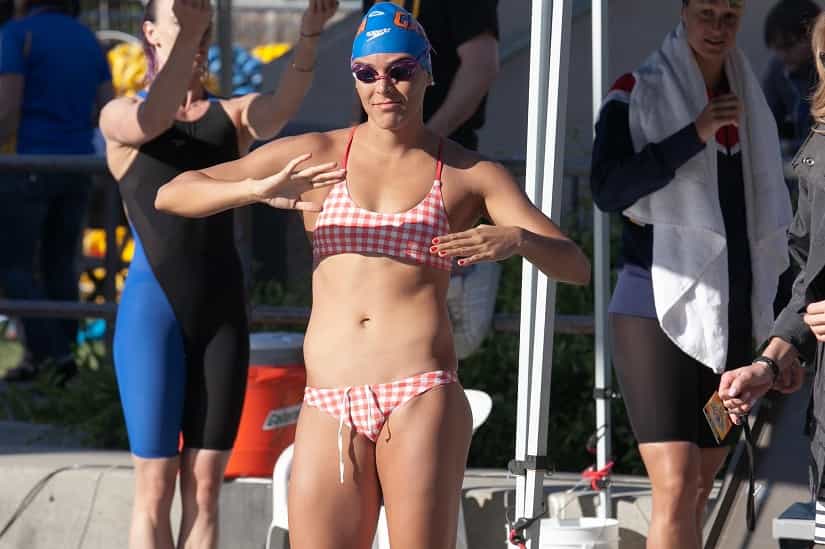
How to Use a Drag Chute for Faster Swimming
Looking for tips on how to use a drag chute for improved swim performances? Read on for some proven tips, sets, and pointers for training with a chute.

One of the simplest ways to make things a little harder on yourself in training is to throw on a drag suit. Here is what you need to know about whether or not it is actually effective in helping you swim faster.
Drag suits have been on pool decks in one form or another basically since day one.
Here is what I mean:
As a teenager during the 1990s my teammates and I all seemed to have a running battle for who rocked out the draggiest of the drag suits—it wouldn’t be uncommon for boys on the team with size 28 waists buying size 40 training suits from the local swim shop.
The effect was rather ridiculous—we looked like we were all wearing diapers.
The things we do for the sport we love, hey?
Since then the practice suit has gone the other way, with equally good reasons—by wearing low resistance suits in practice you better acclimatize yourself to the water, swim at speed, and as a result aren’t surprised and know what to expect when you step up on the blocks.
Although the trend has veered away from having a parachute of a swim suit, there are reasons to rock out the drag suit at practice:
Added resistance and drag.
Training with added resistance is harder, simple as that. The added difficulty will make us stronger, and therefore, faster.
Your drag suit is another form of added resistance–similar to DragSox, or stretch cords, or swimming with a band around your ankles. It’s sport-specific resistance training.
The mental aspect of it.
Using and removing a drag suit can provide a psychological benefit.
For instance, during practice you could do the first round of a high intensity set wearing it, and then drop it for the final round, giving you that little boost or extra sense of speed. Unshackled of the pounds of resistance you are free to fly across the surface of the pool.
This is why you’ll see swimmers at shave-and-swim taper meets wearing their drag suits during their meet warm-up–they want to get a double dose of sleekness when they dive in at race time thanks to the tech suit and the shave down.
In a study done with a group of 18 competitive swimmers the athletes were split into two over the course of a 5-week period. The whole group performed the same weekly practices that featured 3 sprint sets.
One significant effect of the drag suit was that stroke distance decreased. The use of the suits, although well-intentioned, had the side-effect of altering stroke form.
The researchers suggested that drag suits, while a valuable training tool, should be particularly used during shorter, higher intensity sets that have ample rest in order to allow swimmers to maintain proper technique and form.
Which makes sense—wearing a heavy-duty drag suit for a 3,000m for time might seem like a great way to punish yourself into better condition, but if the suit’s resistance is crushing your stroke integrity there isn’t really any point.
Think of your drag suit as one of the tools in your training arsenal. Something that you can add in and out of your workouts as needed.
In the same way you wouldn’t swim with a t-shirt on for the whole practice (the original drag suit), or with DragSox, or with weights around your wrists and ankles (seriously, people do this), use it selectively in scenarios where you can maintain awesome form and technique.
If it affects body position and limits your stroke tempo than it’s usefulness has been lost. Use it in short spurts when you want to add a little bit of resistance to your high-intensity work and as a way to create a contrast in your swimming speed that increases feel for the water.

Olivier Poirier-Leroy Olivier Poirier-Leroy is the founder of YourSwimLog.com. He is an author, former national level swimmer, two-time Olympic Trials qualifier, and swim coach.
✅ Free shipping on Orders over $49
✅ Price Match Guarantee
✅ Best selection of gear for training and competition
✅ Fast and Easy Returns

“This is the best book I have ever seen concerning mental training.” — Ray Benecki, Head Coach, The FISH Swim Team


Looking for tips on how to use a drag chute for improved swim performances? Read on for some proven tips, sets, and pointers for training with a chute.

Ready to take your swimming to the next level? Here are seven ways that a drag chute can help you become a better and faster swimmer.

Wondering if a swim bench can help improve your swimming? Here are six benefits of swim benches for better technique, more power, and faster swimming.

Not breathing into the walls is one of the fundamental skills developing swimmers are taught. Here is how powerful a no-breath approach is for turn and swim speed. Strong training habits are something swimmers hear a lot about from their earliest days of their competitive swimming careers. The greatest hits

Drills with a swim snorkel are one of the best ways to maximize engagement and skill development. Here are five swim snorkel drills to try for faster swimming.

Looking to add some flavor to your kick sets and workouts? Here are some kickboard drills swimmers can use for faster swimming.
SITE
SHOP
GUIDES

LANE 6 PUBLISHING LLC © 2012-2025
Join 33,000+ swimmers and swim coaches learning what it takes to swim faster.
Technique tips, training research, mental training skills, and lessons and advice from the best swimmers and coaches on the planet.
No Spam, Ever. Unsubscribe anytime.
